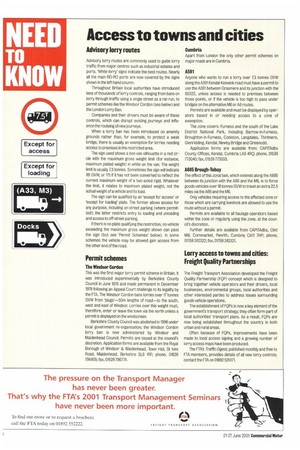Access to towns and cities
Page 38

If you've noticed an error in this article please click here to report it so we can fix it.
Advisory lorry routes
Advisory lorry routes are commonly used to guide lorry traffic from major centres such as industrial estates and ports. White lorry signs indicate the best routes. Nearly all the main 60-R0 ports are now covered by the signs shown in the left hand column.
Throughout Britain local authorities have introduced tens of thousands of lorry controls, ranging from bans on lorry through traffic using a single street as a rat-run, to permit schemes like the Windsor Cordon (see below) and the London Lorry Ban.
Companies and their drivers must be aware of these controls, which can disrupt existing journeys and influence the routeing of newjourneys.
When a lorry ban has been introduced on amenity grounds rather than, for example, to protect a weak bridge, there is usually an exemption for lorries needing access to premises in the restricted area.
The sign used shows a box-van silhouette in a red circle with the maximum gross weight limit (for instance, maximum plated weight) in white on the van. The weight limit is usually 7.5 tonnes. Sometimes the sign will indicate 18t GVW, or 17t if it has not been converted to reflect the current maximum weight of a two-axled rigid. Whatever the limit, it relates to maximum plated weight, not the actual weight of a vehicle and its load.
The sign can be qualified by an 'except for access' or 'except for loading' plate. The former allows access for any purpose, including on-street parking (where permitted); the latter restricts entry to loading and unloading and access to off-street parking.
If there is no plate qualifying the restriction, no vehicle exceeding the maximum gross weight shown can pass the sign (but see 'Permit Schemes' below). In some schemes the vehicle may be allowed gain access from the other end of the road.
Permit schemes
The Windsor Cordon This was the first major lorry permit scheme in Britain. It was introduced experimentally by Berkshire County Council in June 1978 and made permanent in December 1979 following an Appeal Court challenge to its legality by the ETA. The Windsor Cordon bans lorries over 17 tonnes GVW from 'plugs'-50m lengths of road—to the south, west and east of Windsor. Lorries over this weight must, therefore, enter or leave the town via the north unless a permit is displayed on the windscreen.
Berkshire County Council was abolished in 1998 under local government re-organisation; the Windsor Cordon lorry ban is now administered by Windsor and Maidenhead Council. Permits are issued at the council's discretion. Application forms are available from the Royal Borough of Windsor & Maidenhead, Town Hall, St Ives Road, Maidenhead, Berkshire SL6 1RF; phone, 01628 796405; fax, 01628 796774. Cumbria Apart from London the only other permit schemes on major roads are in Cumbria.
A591 Anyone who wants to run a lorry over 7.5 tonnes GVW along the A591Kendal-Keswick road must have a permit to use the 4591 between Grasmere and its junction with the B5322, unless access is needed to premises between those points, or if the vehicle is too high to pass under bridges on the alternative M6 or 46 routes.
Permits are available and must be displayed by operators based in or needing access to a zone of exemption.
The zone covers: Furness and the south of the Lake District National Park, including Barrow-in-Furness, Broughton-in-Furness, Coniston, Langdales, Thirlmere, Glenridding, Kendal, Newby Bridge and Greenodd.
Application forms are available from: CAPITAdbs County Offices, Kendal, Cumbria LA9 4RQ; phone, 01539 773040; fax, 01539773033.
A685 Brough-Tebay
The effect of this zonal ban, which extends along the 4685 between its junction with the 466 and the M6, is to force goods vehicles over 18 tonnes GVW to travel an extra 22.5 miles via the A66 and the M6.
Only vehicles requiring access to the affected zone or those which are carrying livestock are allowed to use the route without a permit.
Permits are available to all haulage operators based within the zone or regularly using the zone, at the council's id scretion.
Further details are available from CAPITAdbs, Clint Mill, Cornmarket, Penrith, Cumbria CA11 7HP; phone, 01768 242322; fax, 01768 242321.
Lorry access to towns and cities: Freight Quality Partnerships
The Freight Transport Association developed the Freight Quality Partnership (FOP) concept which is designed to bring together vehicle operators and their drivers, local businesses, environmental groups, local authorities and other interested parties to address issues surrounding goods vehicle operations.
The establishment of FQPs is now a key element of the government's transport strategy; they often form part of local authorities' transport plans. As a result, FQPs are now being established throughout the country in both urban and rural areas.
Often because of FQPs, improvements have been made to local access signing and a growing number of lorry access maps have been produced.
The FTA's Traffic West, published monthly and free to ETA members, provides details of all new lorry controls; contact the ETA on 01892 526171.
































































































